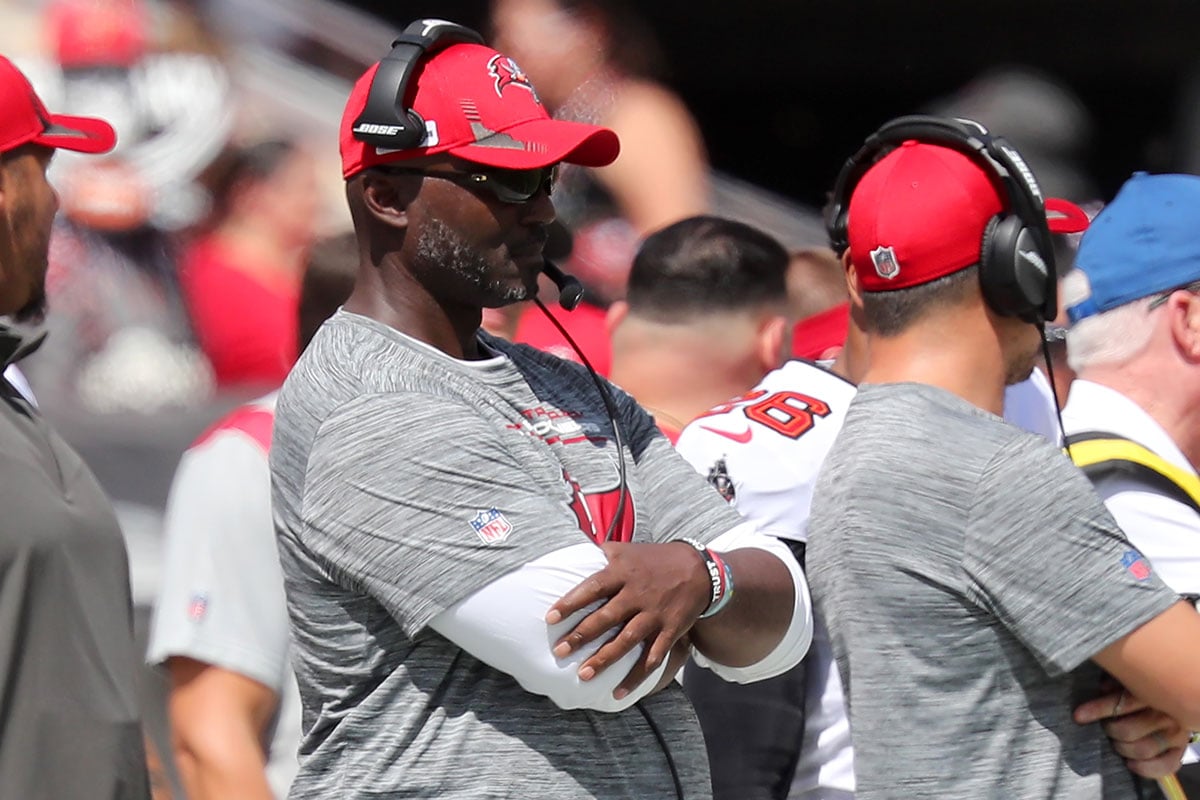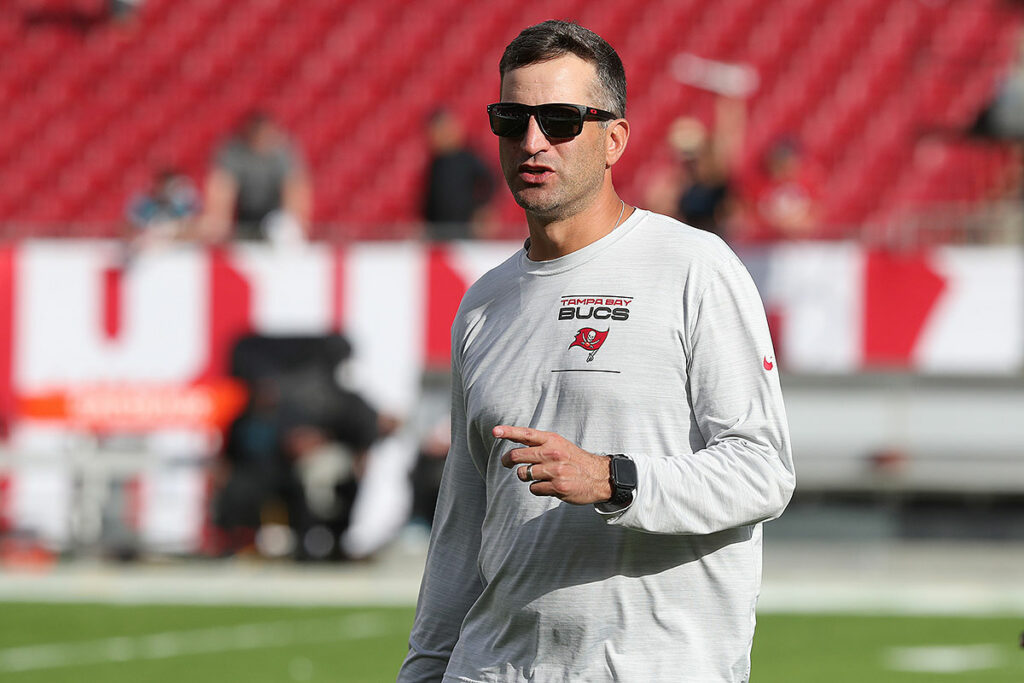The Buccaneers needed Todd Bowles’ best game plan of the season to beat the Rams. They didn’t get it. Unlike in Super Bowl LV, when Tampa Bay beat Patrick Mahomes by playing coverage and daring Kansas City to run the ball, Bowles chose identity over adaptability.
As usual, the Bucs defense was dominant against the run, conceding only 73 yards over 30 attempts. But with only the 20th rushing offense in terms of efficiency, Los Angeles was never going to win this game on the ground. It was their aerial attack — which generated 355 net yards in 41 dropbacks — that was the difference.
No one person is singularly responsible for any win or loss. Football doesn’t work that way. But Bowles is as at least as responsible as anyone else for the game’s outcome. In fairness to the play caller, the execution wasn’t perfect, either.
Execution Errors
still tickled at Bowles running basically soft-sky. down safety carry one seam. deep safety leaning opposite to drop spot side with corner midpoint. never seen another non carroll tree team do it that way https://t.co/Gmpy3Zk6XB
— under zone x (@cmikesspinmove) January 24, 2022
On this play, the Bucs played a variation of Cover 3 known as “Soft Sky“. The free safety cheats slightly to one side while the apex player on the opposite side carries vertically if necessary. In theory, Soft Sky should challenge the seams without overly-sacrificing underneath players the way a defense might if they matched everywhere.
However, Tyler Higbee ran right by Jordan Whitehead for an easy completion.
Soft Sky bust!
Smart from the Patriots to shift into this and get Jamal Adams to check.
MOF Lano Hill scared of #1's post. But this is really bad from him to get looked off so heavily, especially with #2 to the flat.
60-40 over; must help Adams in post pic.twitter.com/aXiVoQiefD
— Under Zone X (Frisco)/Phoenix Check/Stick Slasher2 (@mattyfbrown) September 23, 2020
Although the free safety made a mistake in the above example, notice how Jamal Adams matched Julian Edelman vertically.
I challenge readers to decipher this mess. Jon Ledyard, Scott Reynolds, and I all sent this clip to different scheme experts to try and understand what happened. The collective response could be summed up as a shrug and an “oof.”
From pooling those opinions of people smarter than me, here’s my guess: Tampa Bay was playing 1 Rat. Thus, the inside linebackers — Devin White and Lavonte David — were funneling the running back. Basically, this means that the linebacker closest to the side that the running back releases (David) takes him in man coverage. The other linebacker (White) is free. Alternatively, there may have been a three-on-two funnel involving the strong safety (Whitehead) and the tight end, too. Or, Whitehead may have been simply manned up against the tight end with specific instructions on what to do if the tight end stayed in to block.
On the back end, Jamel Dean passed off the crossing route to Antoine Winfield, Jr. Dean then replaced Winfield as the free safety. Dean may have passed off the route too early, and Winfield may have been late to cut off the crosser — especially given there was no threat of a post route. Who knows?
Somebody messed up. But without being inside the closed doors of One Buccaneer Place, it’s hard to know exactly who.
This one was simple. White, who admitted that he can be over-aggressive at times, abandoned his man to pursuit the quarterback and got burned for a touchdown.
On third-and-19, this was a back-breaker. The Bucs were playing Tampa 2 with Mike Edwards as the strong safety. Edwards has to stay disciplined and hold his position or gain width in these situations. Instead, Matthew Stafford baited Edwards with his eyes by staring down the seam, and Edwards prematurely opened his hips away from the outside receiver.
Stafford ALWAYS stares down the seam to move the safety vs Cover 2.
Just stay on the hash.
He almost got me one time with the same thing 😂— Will Blackmon (@WillBlackmon) January 23, 2022
On the Tampa 2 thing, the aiming point for the Safeties is usually 22 yards deep, 2 yards inside the pro numbers. And you better not go inside until that front hand comes off the ball. You can only work wider and that’s only if #2 blocks or goes out…
— Coach Vass (Join Me on the Other App) (@CoachVass) January 24, 2022
In a vacuum, players need to be held accountable for their mistakes. However, when there’s miscommunication, mental mistakes, and a lack of discipline throughout an entire season, that’s a reflection of the coaching staff.
Blitzing Your Head Against The Wall
This point was discussed ad nauseam leading up to the game: don’t blitz Stafford. With a 41 percent blitz rate, no one sent pressure this season more than Bowles. On the other hand, no one punished blitzes better than the Rams.
In Week 3, Bowles made his version of a compromise by only blitzing on 11 out of 39 dropbacks. Stafford went 8-10 for 81 yards, one touchdown, and one sack. One of the incompletions was a drop, by the way.
In the Divisional Round rematch, Bowles sent five or more rushers on 16 of 41 dropbacks. Predictably, Stafford completed 11 of 16 passes for 136 yards and a touchdown. He didn’t even take a sack. Instead of dialing down the blitz frequency from Week 3, Bowles turned it up.
The Rams wadded it up against the Fire Zone blitz with ease and gave Stafford time to deliver a downfield strike.
I won’t even go into the play — which was the perfect concoction of poor communication and head-scratching play calling.
Anyone But Kupp
The Buccaneers’ strongest plays came when they forced players other than Cooper Kupp to win.
Tampa Bay covered this perfectly. Up top, the cornerbacks staggered their alignment to counter the receiver stack and avoid rubs. Moreover, Dean played Kupp well with safety help from Winfield.
The Bucs were playing Cover 1 while rushing four. Though Sean Murphy-Bunting was singled up against Kupp, Winfield spun down to rob the middle of the field. Once Kupp crossed into Winfield’s zone, Murphy-Bunting passed off the receiver to Winfield. Murphy-Bunting then replaced Winfield as the middle field robber. Perfect!
Yes, the Rams converted this third-and-5 for a first down. But it wasn’t easy. It took Higbee beating David, the Bucs’ best coverage linebacker, one-on-one with a great route off of Sean McVay’s “Arches” concept. In the long run, I’ll take David in this match-up.
Also note that Carlton Davis III was one-on-one against Odell Beckham Jr. I love the idea of effectively double-teaming the offense’s best receiver while trusting your best cornerback to cover their second best receiver by himself. Bill Belichick has done this for years with his “1 Double _” coverages.
Speaking of 1 Double, here’s what Belichick might refer to as “1 Double 10” — but with a twist. White, rather than a cornerback, was playing press man against Kupp while shading outside, and Winfield rotated down to take cover Kupp inside.
Beckham beat Dean, but that was just one heck of a play. I do question the decision to put Davis on Cam Akers rather than Beckham. Perhaps it was to give the illusion of zone coverage with a cornerback across from a running back and a linebacker across from a receiver, but the alignment screamed man the whole way.
Clearly, these coverages didn’t guarantee success. However, they challenged the offense to move the ball without their best player. Unfortunately, these few plays were unrepresentative of the Bucs’ overall strategy, as Kupp finished the game with 183 yards and a touchdown.
Free Yards
Good quarterbacks will take freebies when offered. Look no further than Tom Brady in the Wild Card round. And Stafford, especially with the help of McVay, will feast on free yardage.
With the Buccaneers in soft, spot-dropping 3 Sky, Stafford easily found an opening with a curl-swing combination.
Bowles followed that play up with a soft Quarters coverage. With Murphy-Bunting way off, Van Jefferson picked up a first down with a quick stop route.
Again, Bowles had his corners playing off in 3 Sky. With Kendall Blanton so close to the sideline, Dean correctly played with inside leverage. However, despite Dean contesting well, Stafford placed the ball perfectly outside for Blanton to take advantage of the soft coverage. But that decision doesn’t even sniff the egregious one on the defensive line. Joseph Noteboom, the Rams’ backup left tackle, was left free!
Failure To Attack Noteboom
As the fill-in for future Hall of Famer Andrew Whitworth, Noteboom was the weak spot in Los Angeles’ offensive line. Yet, Bowles failed to take advantage. Jon Ledyard pointed this out on the Pewter Report podcast: instead of attacking Noteboom with Shaquil Barrett — the Bucs’ best pass rusher — the backup left tackle went against Jason Pierre-Paul on the vast majority of snaps. In fact, Barrett only lined up on the offense’s left two times all game!
Pierre-Paul had, by far, the worst season of his career. While he commendably battled through a shoulder injury, the reality is that Pierre-Paul was ineffective. Bowles saw this all year. And it’s not as if either Pierre-Paul or Barrett are exclusively one-sided players. Both had moved around plenty all season.
Because Noteboom was unchallenged, he led the Rams with an 86.3 PFF pass blocking grade. That was by far his highest grade of the year.
Really think about that.
The obvious weak link earned a terrific grade because Bowles didn’t go after him. That’s malpractice. It’s too bad Raheem Morris didn’t show Josh Wells the same courtesy.
As if putting an injured Pierre-Paul across from Noteboom wasn’t bad enough, Bowles used creeper pressures that sent Jordan Whitehead at the left tackle.
Of course, the idea with creepers is to manipulate the protection such that the defense creates a free rusher while only sending four. But this looks terrible. It didn’t need to be complicated. Make their worst lineman block your best pass rusher. Instead, Noteboom’s toughest test was an injured Pierre-Paul.
Conclusion
Again, none of this analysis is meant to detract from errors made on offense or special teams. Everyone could have done their job better. However, this was an abysmal performance from Bowles.
Yes, the Buccaneers defense generated four turnovers. But punch-outs, let alone the ball going over Stafford’s head, had nothing to do with scheme.
That’s not hand-waving away the fumbles. Give the defensive players credit. Still, consider how many points the Rams might have scored had they not been sloppy with the ball.
The soft schedule of opposing offenses inflated the Buccaneers’ defensive statistics over the season. But there were red flags. The hope was that, like last season, Bowles would be radically adaptable when needed. Instead, he blitzed relentlessly, let the offense’s best player go off, and made life easy for the backup left tackle.
Sean McVay didn’t need any help – but Todd Bowles played right into his hands.




